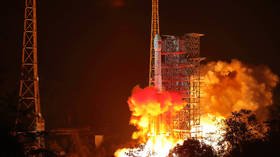Dark side of the Moon: China’s great gig in the sky triggers paranoid US (by Ken Livingstone)

While China and India could soon overtake America as the world’s largest economies, the US has got to come to terms with this and co-operate with China as it does with Russia on space exploration.
The most amazing event of the new year and perhaps the most significant in our future development was the successful landing of a Chinese space craft for the first time in human history on the far side of the Moon.
This was an amazing technical feat as the robotic probe, Chang’e 4, descended on the unexplored South Pole-Aitken basin. This is the largest impacted structure throughout our whole solar system, caused by a massive collision around four billion years ago.
I remember back in 1959 when, for the first time, we saw photographs of the far side of the Moon. They were beamed back to Earth by the Soviet Union’s Luna 3, which showed remarkable differences with the other side of the Moon. The far side has many more craters and is almost missing the seas of solidified lava that are much more common on the side that faces Earth.
Throughout human history we had never seen the other side of the Moon because the Moon spins on its axis at the same rate as it orbits Earth. Martin Wieser of the Swedish Institute of Space Physics said: “We know the far side from orbital images and satellites, but we don’t know it from the surface. It’s unchartered territory and that makes it very exciting.”
Now, we have seen the first remarkable pictures broadcast from the far side of the Moon after Chang’e 4 released its rover, called Yutu 2, and it drove off the ramp and began cruising across the Moon’s surface just twelve hours after it had landed.
Head of the project, Wu Weiren, called it a “small step for the rover but one giant leap for the Chinese nation.” Over the weeks to come the rover will be testing soil, measuring temperatures and seeking to discover how the Moon was created. It will also try to discover how water originated on the Moon in substantially greater amounts than we ever considered possible.
The reason it has taken so long for this to happen is that as a spacecraft goes behind the Moon it loses all radio contact with Earth which is why in 1962 the US Ranger spacecraft crash landed on the far side and failed to send back any information about what was there. The success of China’s landing is because they have stationed a satellite high above the far side of the Moon which is capable of relaying information to and fro between the probe and Earth.
China’s Chang’e 4 still had to operate on its own but had been designed so that once it was nine miles above the Moon its computer used a rocket booster to decelerate until it was just one hundred metres above the surface and got it to hover whilst it looking for a safe place to land.
Professor Andrew Coates of the Mullard Space Science Laboratory at University College London proclaimed: “This is a great technological accomplishment as it was out of sight of Earth, so signals are relayed back by the orbiter and most of the landing was actually done autonomously in difficult terrain. The landing was almost vertical because of the surrounding hills.”
Scientists’ fascination with the far side of the Moon has been about trying to understand why it has so many more deep craters than the other side where lava flows buried the legacy of meteorite impacts. Scientists have speculated for sixty years about why there are such differences on the two sides of the Moon.
The consensus is that this dates back to the origins of our solar system over four billion years ago when all the planets as well as the Moon were bombarded by asteroids created at the beginning at the solar system.
It was not just China’s great success that defined our new year. At the far edge of our solar system NASA’s New Horizons spacecraft was flying past Ultima Thule, an amalgamation of two asteroids. It had taken the spacecraft almost 13 years to reach this point as it flashed past at a speed of 32,000 mph.
Ultima Thule lies at the heart of the Kuiper Belt which is the home of boulders, debris and some dwarf planets. US scientists believe that the information collected by New Horizons could give us insight into what the solar system was like at the time of its creation.
Congratulations to China’s Chang’e-4 team for what appears to be a successful landing on the far side of the Moon. This is a first for humanity and an impressive accomplishment! pic.twitter.com/JfcBVsjRC8
— Jim Bridenstine (@JimBridenstine) January 3, 2019
I find all of this gripping because I grew up in a world where space exploration dominated our news, from the moment in 1957 when the Soviet Union launched the first satellite in human history. Called Sputnik, it orbited the Earth for almost three months and was soon followed by Sputnik 2 which contained Laika, a dog who was the first living creature to ever escape our atmosphere. Sadly she died. Just two years later Luna 2, also launched by the Soviet Union, became the first satellite to reach the Moon.
I can remember the newspapers, radio and television were dominated by these events and it triggered two responses. The first came from the US when American presidents were so traumatised at being overtaken by the Soviets that the newly elected President Kennedy promised Americans would land on the Moon before the end of the 1960s. But it was Yuri Gagarin who was the first human to reach space in USSR’s Vostok spaceship.
Three years later Soviet Aleksey Leonov became the first astronaut to do a spacewalk for just twelve minutes.
The second response was a vast increase in science fiction books which depicted humanity’s future as we soared through space to colonise planets and to eventually fly to other stars. In that period in the 1960s we were convinced that space exploration would be a central part of our future and this seemed to be happening when finally, in 1969, Buzz Aldrin and Neil Armstrong became the first humans to land on the Moon. Just two years later the USSR again achieved a triumph by landing the first ever probe on Mars.
In 1974, NASA launched Mariner 10 which became the first satellite to fly across the surface of Venus and Mercury. This was followed by flybys of Jupiter and Saturn, five years later by Voyager 1. But then it all seemed to be put on hold. The US had spent billions of dollars to land just twelve Americans on the Moon and no one has been back since 1972.
The emergence of China’s space program alongside Russia and America’s is having a big impact. China only sent its first astronaut into space back in 2003 but has now caught up with Russia and the US. But this seems to have triggered a paranoid mentality in America’s leadership, with President Trump creating a new space command for US armed forces as well as treating China as an economic and military rival.
The simple fact is China will soon overtake America as the world’s largest economy and then India will push the US into third place. The US has got to come to terms with this and co-operate with China as it does with Russia on space exploration.
As well as the cost of space exploration being a deterrent in recent decades there has also been a fear that radiation levels in space could kill astronauts on long journeys and there is also the problem of the lack of gravity.
When astronauts return to Earth after spending months in a satellite, they couldn’t walk and have to be carried off the spacecraft. But we know now that human bodies recover very quickly from these impacts and I believe it’s possible that in years to come we can invent mechanisms that protect astronauts from radiation and build large revolving spacecraft which would replicate Earth’s gravity. But the cost of all of this means nations have to collaborate and not operate as rivals. The US government spends just nineteen billion a year on its space budget which is just half of one percent of the federal budget. Back in the days of Kennedy, America was spending more than four percent of its budget on space exploration.
The threat to human life on our planet from climate change and the super volcanoes means that the only way humanity can survive is by spreading out to other worlds. So, let us hope the three superpowers co-operate in the years to come and accept India which is beginning to develop its own space program with launches planned for 2022.
In recent years national spaces agencies in 14 countries have cooperated and their most recent plan published just a year ago said they had agreed to “expand human presence into the solar system with the surface of Mars as a common driving goal.”
Like this story? Share it with a friend!
The statements, views and opinions expressed in this column are solely those of the author and do not necessarily represent those of RT.















